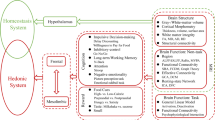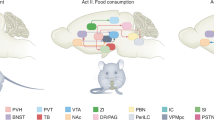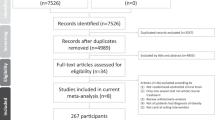Abstract
An increasingly influential perspective conceptualizes both obesity and overeating as a food addiction accompanied by corresponding brain changes. Because there are far-reaching implications for clinical practice and social policy if it becomes widely accepted, a critical evaluation of this model is important. We examine the current evidence for the link between addiction and obesity, identifying several fundamental shortcomings in the model, as well as weaknesses and inconsistencies in the empirical support for it from human neuroscientific research.
This is a preview of subscription content, access via your institution
Access options
Subscribe to this journal
Receive 12 print issues and online access
$189.00 per year
only $15.75 per issue
Buy this article
- Purchase on Springer Link
- Instant access to full article PDF
Prices may be subject to local taxes which are calculated during checkout

Similar content being viewed by others
References
Swinburn, B. A. et al. The global obesity pandemic: shaped by global drivers and local environments. Lancet 378, 804–814 (2011).
Hall, K. D. et al. Quantification of the effect of energy imbalance on bodyweight. Lancet 378, 826–837 (2011).
Gearhardt, A. N., Grilo, C. M., Dileone, R. J., Brownell, K. D. & Potenza, M. N. Can food be addictive? Public health and policy implications. Addiction 106, 1208–1212 (2011).
Devlin, M. J. Is there a place for obesity in DSM-V? Int. J. Eat. Disord. 40, S83–S88 (2007).
Volkow, N. D. & O'Brien, C. P. Issues for DSM-V: should obesity be included as a brain disorder? Am. J. Psychiatry 164, 708–710 (2007).
Ifland, J. R. et al. Refined food addiction: a classic substance use disorder. Med. Hypotheses 72, 518–526 (2009).
Cocores, J. A. & Gold, M. S. The Salted Food Addiction Hypothesis may explain overeating and the obesity epidemic. Med. Hypotheses 73, 892–899 (2009).
Volkow, N. D., Wang, G.-J. & Baler, R. D. Reward, dopamine and the control of food intake: implications for obesity. Trends Cogn. Sci. 15, 37–46 (2011).
Volkow, N. D. & Wise, R. A. How can drug addiction help us understand obesity? Nature Neurosci. 8, 555–560 (2005).
Kelley, A. E. & Berridge, K. C. The neuroscience of natural rewards: relevance to addictive drugs. J. Neurosci. 22, 3306–3311 (2002).
Benton, D. The plausibility of sugar addiction and its role in obesity and eating disorders. Clin. Nutr. 29, 288–303 (2010).
American Psychiatric Association. Diagnostic and Statistical Manual of Mental Disorders 4th edn (American Psychiatric Association, Washington, DC, 2000).
Gearhardt, A. N., Corbin, W. R. & Brownell, K. D. Preliminary validation of the Yale Food Addiction Scale. Appetite 52, 430–436 (2009).
Gearhardt, A. N., Corbin, W. R. & Brownell, K. D. Food addiction: an examination of the diagnostic criteria for dependence. J. Addict. Med. 3, 1–7 (2009).
Davis, C. & Carter, J. C. Compulsive overeating as an addiction disorder. A review of theory and evidence. Appetite 53, 1–8 (2009).
Striegel-Moore, R. H. & Franko, D. L. Epidemiology of binge eating disorder. Int. J. Eat. Disord. 34, S19–S29 (2003).
O'Rahilly, S. Human genetics illuminates the paths to metabolic disease. Nature 462, 307–314 (2009).
Drewnowski, A. Obesity, diets, and social inequalities. Nutr. Rev. 67, S36–S39 (2009).
Davis, C. et al. Evidence that 'food addiction' is a valid phenotype of obesity. Appetite 57, 711–717 (2011).
Wang, G. J. et al. Enhanced striatal dopamine release during food stimulation in binge eating disorder. Obesity 19, 1601–1608 (2011).
Avena, N. M., Rada, P. & Hoebel, B. G. Evidence for sugar addiction: behavioral and neurochemical effects of intermittent, excessive sugar intake. Neurosci. Biobehav. Rev. 32, 20–39 (2008).
Wang, G. J. et al. Brain dopamine and obesity. Lancet 357, 354–357 (2001).
Cassin, S. E. & von Ranson, K. M. Is binge eating experienced as an addiction? Appetite 49, 687–690 (2007).
Grucza, R. A. et al. The emerging link between alcoholism risk and obesity in the United States. Arch. Gen. Psychiatry 67, 1301–1308 (2010).
Lilenfeld, L. R. R., Ringham, R., Kalarchian, M. A. & Marcus, M. D. A family history study of binge-eating disorder. Compr. Psychiatry 49, 247–254 (2008).
Stice, E., Spoor, S., Bohon, C. & Small, D. M. Relation between obesity and blunted striatal response to food is moderated by TaqIA A1 allele. Science 322, 449–452 (2008).
Stice, E., Yokum, S., Bohon, C., Marti, N. & Smolen, A. Reward circuitry responsivity to food predicts future increases in body mass: moderating effects of DRD2 and DRD4. Neuroimage 50, 1618–1625 (2010).
Felsted, J. A., Ren, X., Chouinard-Decorte, F. & Small, D. M. Genetically determined differences in brain response to a primary food reward. J. Neurosci. 30, 2428–2432 (2011).
Munafo, M. R., Matheson, I. J. & Flint, J. Association of the DRD2 gene Taq1A polymorphism and alcoholism: a meta-analysis of case-control studies and evidence of publication bias. Mol. Psychiatry 12, 454–461 (2007).
Noble, E. P. et al. Allelic association of the D2 dopamine receptor gene with cocaine dependence. Drug Alcohol Depend. 33, 271–285 (1993).
Zuo, Y. et al. DRD2-related TaqIA polymorphism modulates motivation to smoke. Nicotine Tob. Res. 11, 1321–1329 (2009).
Doehring, A. et al. Genetic variants altering dopamine D2 receptor expression or function modulate the risk of opiate addiction and the dosage requirements of methadone substitution. Pharmacogenet. Genomics 19, 407–414 (2009).
Davis, C. A. et al. Dopamine for “wanting” and opioids for “liking”: a comparison of obese adults with and without binge eating. Obesity 17, 1220–1225 (2009).
Smith, L., Watson, M., Gates, S., Ball, D. & Foxcroft, D. Meta-analysis of the association of the Taq1A polymorphism with the risk of alcohol dependency: a HuGE gene-disease association review. Am. J. Epidemiol. 167, 125–138 (2008).
Munafo, M. R., Timpson, N. J., David, S. P., Ebrahim, S. & Lawlor, D. A. Association of the DRD2 gene Taq1A polymorphism and smoking behavior: a meta-analysis and new data. Nicotine Tob. Res. 11, 64–76 (2009).
Fernandez-Castillo, N. et al. Association study between the DAT1, DBH and DRD2 genes and cocaine dependence in a Spanish sample. Psychiatr. Genet. 20, 317–320 (2010).
Pohjalainen, T. et al. The A1 allele of the human D2 dopamine receptor gene predicts low D2 receptor availability in healthy volunteers. Mol. Psychiatry 3, 256–260 (1998).
Jonsson, E. G. et al. Polymorphisms in the dopamine D2 receptor gene and their relationships to striatal dopamine receptor density of healthy volunteers. Mol. Psychiatry 4, 290–296 (1999).
Davis, C. et al. Opiates, overeating and obesity: a psychogenetic analysis. Int. J. Obes. 35, 1347–1354 (2011).
Miranda, R. et al. Initial evidence of an association between OPRM1 and adolescent alcohol misuse. Alcohol. Clin. Exp. Res. 34, 112–122 (2010).
Ramchandani, V. A. et al. A genetic determinant of the striatal dopamine response to alcohol in men. Mol. Psychiatry 16, 809–817 (2011).
Comings, D. E. & Blum, K. Reward deficiency syndrome: genetic aspects of behavioral disorders. Prog. Brain Res. 126, 325–341 (2000).
Davis, C. & Fox, J. Sensitivity to reward and body mass index (BMI): evidence for a non-linear relationship. Appetite 50, 43–49 (2008).
Verdejo-Garcia, A., Lawrence, A. J. & Clark, L. Impulsivity as a vulnerability marker for substance-use disorders: review of findings from high-risk research, problem gamblers and genetic association studies. Neurosci. Biobehav. Rev. 32, 777–810 (2008).
Limosin, F. et al. Impulsiveness as the intermediate link between the dopamine receptor D2 gene and alcohol dependence. Psychiatr. Genet. 13, 127–129 (2003).
Eisenberg, D. T. et al. Examining impulsivity as an endophenotype using a behavioral approach: a DRD2 TaqI A and DRD4 48-bp VNTR association study. Behav. Brain Funct. 3, 2 (2007).
Guerrieri, R. et al. The influence of trait and induced state impulsivity on food intake in normal-weight healthy women. Appetite 49, 66–73 (2007).
Galanti, K., Gluck, M. E. & Geliebter, A. Test meal intake in obese binge eaters in relation to impulsivity and compulsivity. Int. J. Eat. Disord. 40, 727–732 (2007).
Davis, C. et al. Personality and eating behaviors: a case–control study of binge eating disorder. Int. J. Eat. Disord. 41, 243–250 (2008).
Kenny, P. J. Common cellular and molecular mechanisms in obesity and drug addiction. Nature Rev. Neurosci. 12, 638–651 (2011).
Bocarsly, M. E., Berner, L. A., Hoebel, B. G. & Avena, N. M. Rats that binge eat fat-rich food do not show somatic signs or anxiety associated with opiate-like withdrawal: implications for nutrient-specific food addiction behaviors. Physiol. Behav. 104, 865–872 (2011).
Avena, N. M., Rada, P., Moise, N. & Hoebel, B. G. Sucrose sham feeding on a binge schedule releases accumbens dopamine repeatedly and eliminates the acetylcholine satiety response. Neuroscience 139, 813–820 (2006).
Avena, N. M., Rada, P. & Hoebel, B. G. Sugar and fat bingeing have notable differences in addictive-like behavior. J. Nutr. 139, 623–628 (2009).
Johnson, P. M. & Kenny, P. J. Dopamine D2 receptors in addiction-like reward dysfunction and compulsive eating in obese rats. Nature Neurosci. 13, 635–641 (2010).
Avena, N. M., Long, K. A. & Hoebel, B. G. Sugar-dependent rats show enhanced responding for sugar after abstinence: evidence of a sugar deprivation effect. Physiol. Behav. 84, 359–362 (2005).
Colantuoni, C. et al. Evidence that intermittent, excessive sugar intake causes endogenous opioid dependence. Obes Res. 10, 478–488 (2002).
Rada, P., Avena, N. M. & Hoebel, B. G. Daily bingeing on sugar repeatedly releases dopamine in the accumbens shell. Neuroscience 134, 737–744 (2005).
Colantuoni, C. et al. Excessive sugar intake alters binding to dopamine and mu-opioid receptors in the brain. Neuroreport 12, 3549–3552 (2001).
Ahmed, S. H., Kenny, P. J., Koob, G. F. & Markou, A. Neurobiological evidence for hedonic allostasis associated with escalating cocaine use. Nature Neurosci. 5, 625–626 (2002).
Kenny, P. J., Chen, S. A., Kitamura, O., Markou, A. & Koob, G. F. Conditioned withdrawal drives heroin consumption and decreases reward sensitivity. J. Neurosci. 26, 5894–5900 (2006).
Geiger, B. M. et al. Deficits of mesolimbic dopamine neurotransmission in rat dietary obesity. Neuroscience 159, 1193–1199 (2009).
Geiger, B. M. et al. Evidence for defective mesolimbic dopamine exocytosis in obesity-prone rats. FASEB J. 22, 2740–2746 (2008).
Rada, P., Bocarsly, M. E., Barson, J. R., Hoebel, B. G. & Leibowitz, S. F. Reduced accumbens dopamine in Sprague-Dawley rats prone to overeating a fat-rich diet. Physiol. Behav. 101, 394–400 (2010).
Corwin, R. L. & Grigson, P. S. Symposium overview-food addiction: fact or fiction? J. Nutr. 139, 617–619 (2009).
Volkow, N. D. et al. Low dopamine striatal D2 receptors are associated with prefrontal metabolism in obese subjects: possible contributing factors. Neuroimage 42, 1537–1543 (2008).
Small, D. M., Jones-Gotman, M. & Dagher, A. Feeding-induced dopamine release in dorsal striatum correlates with meal pleasantness ratings in healthy human volunteers. Neuroimage 19, 1709–1715 (2003).
Volkow, N. D. et al. Brain dopamine is associated with eating behaviors in humans. Int. J. Eat. Disord. 33, 136–142 (2003).
Volkow, N. D. et al. “Nonhedonic” food motivation in humans involves dopamine in the dorsal striatum and methylphenidate amplifies this effect. Synapse 44, 175–180 (2002).
Haltia, L. T. et al. Effects of intravenous glucose on dopaminergic function in the human brain in vivo. Synapse 61, 748–756 (2007).
Steele, K. E. et al. Alterations of central dopamine receptors before and after gastric bypass surgery. Obes. Surg. 20, 369–374 (2010).
Dunn, J. P. et al. Decreased dopamine type 2 receptor availability after bariatric surgery: preliminary findings. Brain Res. 1350, 123–130 (2010).
Volkow, N. D., Wang, G. J., Fowler, J. S. & Tomasi, D. Addiction circuitry in the human brain. Annu. Rev. Pharmacol. Toxicol. 52, 321–336 (2012).
Passamonti, L. et al. Personality predicts the brain's response to viewing appetizing foods: the neural basis of a risk factor for overeating. J. Neurosci. 29, 43–51 (2009).
Kullmann, S. et al. The obese brain: association of body mass index and insulin sensitivity with resting state network functional connectivity. Hum. Brain Mapp. 21 Apr 2011 (doi:10.1002/hbm.21268).
Everitt, B. J. et al. Review. Neural mechanisms underlying the vulnerability to develop compulsive drug-seeking habits and addiction. Phil. Trans. R. Soc. B 363, 3125–3135 (2008).
Dalley, J. W. et al. Nucleus accumbens D2/3 receptors predict trait impulsivity and cocaine reinforcement. Science 315, 1267–1270 (2007).
Koob, G. F. & Le Moal, M. Review. Neurobiological mechanisms for opponent motivational processes in addiction. Phil. Trans. R. Soc. B 363, 3113–3123 (2008).
Robinson, T. E. & Berridge, K. C. The neural basis of drug craving: an incentive-sensitization theory of addiction. Brain Res. Brain Res. Rev. 18, 247–291 (1993).
Volkow, N. D. et al. Low level of brain dopamine D2 receptors in methamphetamine abusers: association with metabolism in the orbitofrontal cortex. Am. J. Psychiatry 158, 2015–2021 (2001).
Deroche-Gamonet, V., Belin, D. & Piazza, P. V. Evidence for addiction-like behavior in the rat. Science 305, 1014–1017 (2004).
Robbins, T. W., Gillan, C. M., Smith, D. G., de Wit, S. & Ersche, K. D. Neurocognitive endophenotypes of impulsivity and compulsivity: towards dimensional psychiatry. Trends Cogn. Sci. 16, 81–91 (2012).
Vandenbroeck, P., Goossens, J. & Clemens, M. Tackling Obesities: Future Choices — Obesity System Atlas (Government Office for Science, UK, 2007).
Rothemund, Y. et al. Differential activation of the dorsal striatum by high-calorie visual food stimuli in obese individuals. Neuroimage 37, 410–421 (2007).
Martin, L. E. et al. Neural mechanisms associated with food motivation in obese and healthy weight adults. Obesity 18, 254–260 (2010).
Davids, S. et al. Increased dorsolateral prefrontal cortex activation in obese children during observation of food stimuli. Int. J. Obes. 34, 94–104 (2010).
Bruce, A. S. et al. Obese children show hyperactivation to food pictures in brain networks linked to motivation, reward and cognitive control. Int. J. Obes 34, 1494–1500 (2010).
Schienle, A., Schäfer, A., Hermann, A. & Vaitl, D. Binge-eating disorder: reward sensitivity and brain activation to images of food. Biol. Psychiatry 65, 654–661 (2009).
Brooks, S. J. et al. Differential neural responses to food images in women with bulimia versus anorexia nervosa. PLoS ONE 6, e22259 (2011).
Stice, E., Yokum, S., Blum, K. & Bohon, C. Weight gain is associated with reduced striatal response to palatable food. J. Neurosci. 30, 13105–13109 (2010).
Yokum, S., Ng, J. & Stice, E. Attentional bias to food images associated with elevated weight and future weight gain: an FMRI study. Obesity 19, 1775–1783 (2011).
Killgore, W. D. S. & Yurgelun-Todd, D. A. Body mass predicts orbitofrontal activity during visual presentations of high-calorie foods. Neuroreport 16, 859–863 (2005).
Batterink, L., Yokum, S. & Stice, E. Body mass correlates inversely with inhibitory control in response to food among adolescent girls: an fMRI study. Neuroimage 52, 1696–1703 (2010).
Ng, J., Stice, E., Yokum, S. & Bohon, C. An fMRI study of obesity, food reward, and perceived caloric density. Does a low-fat label make food less appealing? Appetite 57, 65–72 (2011).
Stice, E., Spoor, S., Bohon, C., Veldhuizen, M. G. & Small, D. M. Relation of reward from food intake and anticipated food intake to obesity: a functional magnetic resonance imaging study. J. Abnorm. Psychol. 117, 924–935 (2008).
Gearhardt, A. N. et al. Neural correlates of food addiction. Arch. Gen. Psychiatry 68, 808–816 (2011).
DelParigi, A., Chen, K., Salbe, A. D., Reiman, E. M. & Tataranni, P. A. Sensory experience of food and obesity: a positron emission tomography study of the brain regions affected by tasting a liquid meal after a prolonged fast. Neuroimage 24, 436–443 (2005).
Le, D. S. et al. Less activation of the left dorsolateral prefrontal cortex in response to a meal: a feature of obesity. Am. J. Clin. Nutr. 84, 725–731 (2006).
Le, D. S. et al. Less activation in the left dorsolateral prefrontal cortex in the reanalysis of the response to a meal in obese than in lean women and its association with successful weight loss. Am. J. Clin. Nutr. 86, 573–579 (2007).
Frank, G. K. W., Reynolds, J. R., Shott, M. E. & O'Reilly, R. C. Altered temporal difference learning in bulimia nervosa. Biol. Psychiatry 70, 728–735 (2011).
Bohon, C. & Stice, E. Reward abnormalities among women with full and subthreshold bulimia nervosa: a functional magnetic resonance imaging study. Int. J. Eat. Disord. 44, 585–595 (2010).
Karhunen, L. J. et al. Regional cerebral blood flow during exposure to food in obese binge eating women. Psychiatry Res. 99, 29–42 (2000).
Acknowledgements
We would like to thank B. Everitt for his comments, particularly on Box 2. H.Z. is jointly funded by the Wellcome Trust and GlaxoSmithKline. I.S.F. and P.C.F. are supported by the Bernard Wolfe Health Neuroscience Fund. H.Z., I.S.F. and P.C.F. are also supported by the Wellcome Trust, MRC (Medical Research Council) Centre for Obesity and Related Diseases, and the UK National Institute for Health Research (NIHR) Cambridge Biomedical Research Centre. This work was carried out at the Institute of Metabolic Science and the Wellcome–MRC-funded Behavioural and Clinical Neuroscience Institute. It was inspired by discussions with fellow members of the Behaviour and Health Research Unit.
Author information
Authors and Affiliations
Corresponding author
Ethics declarations
Competing interests
H.Z. is supported by a GlaxoSmithKline–Wellcome translational medicine Ph.D. studentship. P.C.F. has recieved consultancy fees from GlaxoSmithKline.
Related links
Rights and permissions
About this article
Cite this article
Ziauddeen, H., Farooqi, I. & Fletcher, P. Obesity and the brain: how convincing is the addiction model?. Nat Rev Neurosci 13, 279–286 (2012). https://doi.org/10.1038/nrn3212
Published:
Issue Date:
DOI: https://doi.org/10.1038/nrn3212
This article is cited by
-
Current perspectives on brain circuits involved in food addiction-like behaviors
Journal of Neural Transmission (2024)
-
Food addiction and its relationship with other eating behaviours among Spanish university students
Journal of Eating Disorders (2023)
-
A neuromarker for drug and food craving distinguishes drug users from non-users
Nature Neuroscience (2023)
-
Food addiction and emotional eating are associated with intradaily rest–activity rhythm variability
Eating and Weight Disorders - Studies on Anorexia, Bulimia and Obesity (2022)
-
Association between food addiction and time perspective during COVID-19 isolation
Eating and Weight Disorders - Studies on Anorexia, Bulimia and Obesity (2022)



